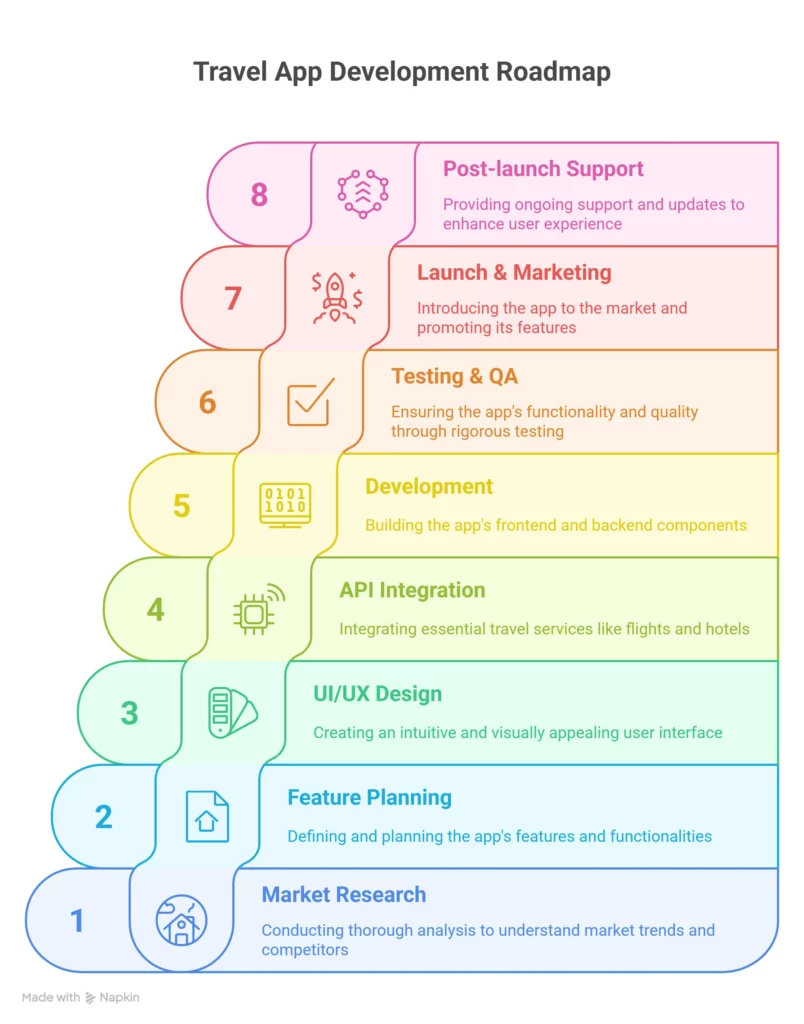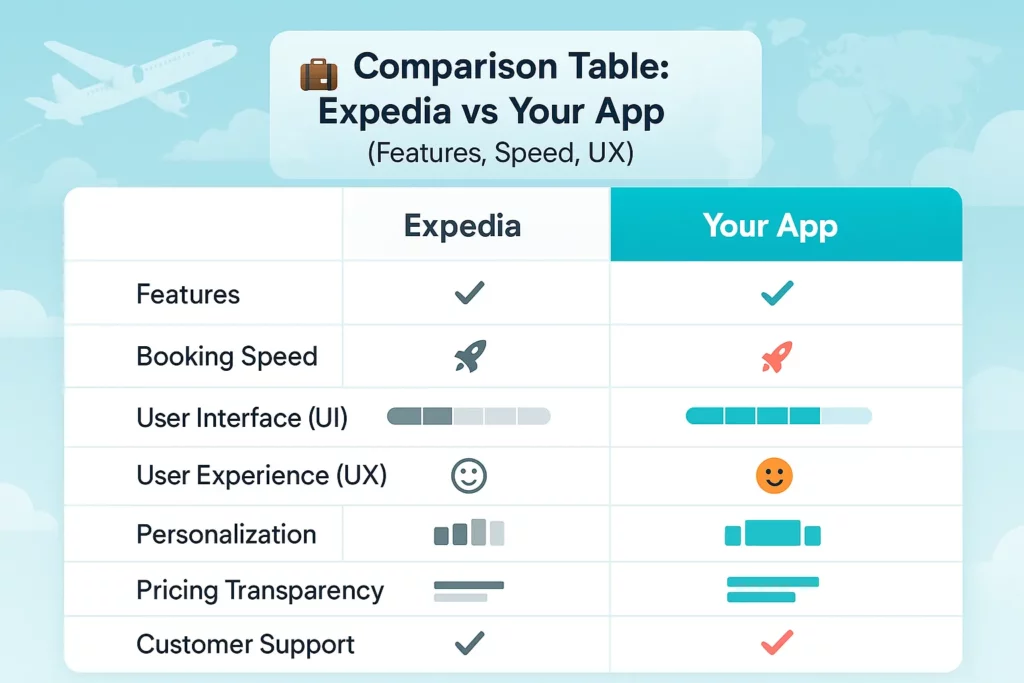The travel industry in 2025 is booming—and evolving faster than ever. With the rise of digital nomads, last-minute getaways, and mobile-first booking behavior, travelers crave seamless, personalized, and smart experiences. Gone are the days of flipping through multiple tabs to book a flight, hotel, and rental car. Today, people expect everything at their fingertips, with one tap, one feed, and one app. That’s where Expedia-style apps shine.
I remember trying to book a cross-country trip last year. I used one app for flights, another for a hotel, and a third for airport transfers. It was a pain. That’s when it hit me: What if someone built a one-stop travel app that doesn’t suck? Think Expedia, but modern. With cleaner UI, faster results, and fewer hidden fees. It’s not just a good idea—it’s a market opportunity.
In this blog, I’ll walk you through how to develop an Expedia-style app from scratch—or at least from the ground floor. Whether you’re a tech startup, a solo founder, or a development agency looking to break into travel tech, you’ll find actionable insights here. We’ll talk features, APIs, UX tips, and even revenue models.
At Miracuves, we specialize in building scalable, user-friendly travel platforms that empower founders to launch faster and smarter in a competitive market.
Ready to build the next big thing in travel? Let’s unpack it.

Read more: – What is MakeMyTrip App and How Does It Work?
Why Build an Expedia-Like App?
Travel booking has officially gone mobile. According to Statista, over 70% of travel-related bookings in 2025 are happening on smartphones. And it’s not just flights. People want to book everything—hotels, car rentals, local experiences, even insurance—without ever switching apps.
Here’s why this matters:
- Fragmented platforms frustrate users.
- Travel apps like Expedia rake in billions.
- There’s plenty of room for innovation with AI, personalization, and clean UX.
Building your own Expedia-style app means stepping into a lucrative space with demand across the globe—and giving users a smarter, more intuitive way to book.

Key Features to Include
1. Multi-Service Booking Engine
Let users book flights, hotels, car rentals, buses, cruises, and local experiences—all from one dashboard.
2. Real-Time Inventory via APIs
Sync listings and availability using GDS APIs like:
- Amadeus
- Sabre
- Skyscanner
- Booking.com
- Hotelbeds
3. Smart Filters and Search
Filters like:
- “WiFi-ready”
- “Late check-in”
- “Pet-friendly”
- “EV charging stations nearby”
Bonus: Add voice search and AI-powered suggestions based on past trips.
4. In-App Wallet & Rewards
Offer built-in payment systems (Stripe, Razorpay, Apple Pay), plus loyalty points, discount tiers, and promo codes.
5. Trip Planner & AI Concierge
Think itinerary builder meets chatbot. Help users plan day-by-day travel automatically using their bookings.
6. Reviews, Maps & Social Proof
In-app Google Maps, verified reviews, and user-uploaded images are a must. Let people see what they’re booking.
Recommended Tech Stack
| Component | Recommended Tools |
| Frontend | Flutter (cross-platform), React Native |
| Backend | Node.js, Laravel, or Django |
| Database | PostgreSQL + MongoDB + Redis |
| APIs | Amadeus, Agoda, Booking.com, Skyscanner |
| Payments | Stripe, PayPal, Razorpay |
| Cloud/DevOps | AWS, Firebase, Docker |
| AI Integration | OpenAI for chat, Firebase ML for suggestions |
Pro Tip: Go modular. Build microservices for each segment (flights, hotels, support) so you can scale faster.
Read more: How to Market an Online Travel Agency Platform App Successfully After Launch
Design Tips for Killer UX
- Swipe-friendly cards for listings
- Sticky CTAs (like “Book Now”) on scroll
- Dark mode support
- Progressive booking bar (like checkout steps)
- Map-first browsing (search by pin drop instead of city name)
Want to stand out? Add a feature where users can split bookings with friends, or book group trips together in-app.
Read more: Online Travel Marketplace Development: Full Cost Breakdown
Monetization Strategies
You’re building a business, not a hobby. Here’s how to earn:
- Commission cuts from hotels, airlines, and experiences
- Service fees added to bookings
- Ads & sponsored listings
- Subscription perks (free upgrades, no service fees, cashback)
You can even launch B2B booking portals for travel agents or corporate clients.
Challenges to Prepare For
- API Reliability: Work with multiple providers to avoid data blackouts.
- Compliance: PCI-DSS for payments, GDPR for data, etc.
- Support: Have live chat and AI bots ready for cancellations, refunds, and itinerary changes.
- Trust: Use verified bookings only for reviews, show transparent pricing, and build a clean, fast UI.
Conclusion: Building for 2025 and Beyond
Travel isn’t just about moving from point A to point B anymore. It’s about convenience, personalization, and trust. If you can develop an Expedia-style app that truly solves traveler pain points—with the right blend of tech and UX—you won’t just be competing with the big guys. You’ll be carving out your own niche.
The tools are available. The demand is exploding.Let’s build together.
FAQs
Still have questions about developing an Expedia app? Let’s break it down.
Q1. How long does it take to build an Expedia-like app?
Typically 4–8 months, depending on complexity and features. Using white-label platforms can cut that time in half.
Q2. What’s the best API for hotel listings?
Anywhere from $20,000 to $100,000 depending on features, complexity, and region.
Q3. Do I need a travel license to operate?
If you’re only aggregating listings, not always. But to take direct payments or operate tours, local regulations may apply.
Q4. Can I launch this app with no-code tools?
You can build an MVP using tools like Glide or Adalo, but expect limitations in scaling and feature depth.
Q5. What’s better: Native or cross-platform development?
Cross-platform (Flutter or React Native) saves cost and time, ideal for startups. Go native only if you need high performance.
Q6. How can I stand out from Expedia?
Focus on personalization, speed, modern UX, and niche features—like sustainability tags, solo travel filters, or crypto payments.
Realted Articles:








